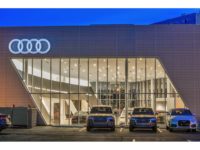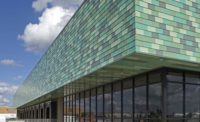Providing access to daylight has been an established principle of occupant-centric design for decades. Natural light helps stabilize and boost mood, decrease fatigue, reduce stress and regulate circadian rhythms. Over 30 years of research have shown that these benefits can increase test scores in school, boost productivity in the workplace and even aid in recovery in healthcare settings. However, unlike the aforementioned building types, airports present a complex array of user experiences, from the airport staff’s long shifts to short visits of flight crews and passengers, which can make it difficult to accurately quantify the benefits of natural light in these applications.
That said, all visitors can benefit from increased access to daylight. It can reduce the stress of traveling as well as contribute to staff wellbeing. Designers can provide natural light to terminal interiors by specifying glass curtain walls along the building envelope.
For example, the terminal expansion of Oklahoma City’s Will Rogers World Airport features four interior and two exterior curtain wall systems of transparent glass held in place with narrow stainless steel frames. These curtain walls increase the amount of natural light within the terminal, bolster the visual connection between spaces, enhance security and update the overall design aesthetic of the airport—all of which translate to a better experience for passengers and staff.
World-class curtain walls improve access to daylight
The transparent glass floods the airport’s terminal with an incredible amount of light. Because the frames are supported with a backup steel system that’s part of the building structure, they boast an astonishing amount of strength despite their narrowness. This allows the curtain wall systems to incorporate as much glass as possible. With little obstruction from framing components, the exterior curtain wall systems not only provide the utmost access to daylight but also contribute to a sleek and contemporary design.
Interior curtain walls aid daylighting goals while also creating a security barrier between the terminal waiting area and ticketing. These glass barriers help regulate the flow of passengers into the concourse without sacrificing the visual connection between the two spaces, which can be key to creating an easily navigable space and maximizing daylight throughout the space.
The sky’s the limit for glazing area
Glass curtain walls that are framed in narrow profile steel frames can span greater heights than those made from aluminum, maximizing the area of glazing for an unprecedented amount of daylight and visual connection. This translates to systems that are functional and aesthetically pleasing. At the Will Rogers World Airport, the curtain walls reach heights up to 30 feet. They also sport larger-than-average expanses of uninterrupted glass. Mike Marlin, the project manager at Avenue C Glass, the glazing company that installed the glass, says, “The scale of these systems is impressive. It’s some of the biggest glazing work we’ve done.”
While the size of the assemblies presented some challenges for the glaziers, the systems helped elevate the terminal expansion’s open design concept.
Achieve daylighting goals without sacrificing individuality
The Will Rogers World Airport’s expansion sought to elevate the Oklahoma City terminal aesthetically and for a better travel experience. However, the design presented two challenges for its external curtain wall system.
The landside of the airport is radiused to match the slight curve of the passenger drop-off road. To preserve this profile, the designers chose to segment the curtain wall system slightly to follow the path of the road. This was a first for Avenue C Glass and demanded a level of exactitude that exceeds most curtain wall installations. The second challenge was that the airside wall assembly drops below the floor line, so it appears to float.
The systems used in the Will Rogers World Airport were able to help the project teams overcome these design challenges. As such, these curtain walls all but prove that flooding an interior with natural light and preserving unique architectural elements need not be mutually exclusive. More generally, their ability to adapt to the particular details of a space can help airport managers and designers create stunning exterior profiles that also support the psychological needs of those within.
A streamlined system eases installation
At the Will Rogers World Airport, the steel backup system connected to the building helped to simplify the installation by negating the need for additional intermediate support members. The stainless steel framing systems used in the project can span almost nine more feet than aluminum curtain walls and generally require less reinforcement. These qualities, in conjunction with the streamlined anchoring system, can help reduce on-site complications. This decreases projected construction timelines and mitigates costly installation errors.
Despite the ambitious nature of the Will Rogers World Airport expansion, the curtain wall systems handled the challenges without over-complication. Their streamlined design allowed the glaziers to focus on the built environment instead of a difficult assembly.
“The curtain walls were satisfying to install,” Marlin states, “and they are simpler than most.” The ease with which these systems were installed helped the glazing team tackle the unique concave bow of the exterior application as well as the 30-foot spans of the interior curtain walls—two firsts for Avenue C Glass.
Despite the additional step of shop-glazing, the systems were installed into the site-erected framing without a hitch, thanks in part to the efficiency with which the cassette frames anchored into the backing members. Because they streamline installation, these curtain walls offer specifiers a substantial payoff to the intense design and engineering process while also contributing to an airport’s world-class look.
A leap forward
“The bow, stainless steel frames and large spans—all of it was a leap forward for us,” Marlin concludes. From some of the biggest panels of glass the glazier handled to the heavy-duty mullions, the curtain wall systems at the Will Rogers World Airport push the boundaries of what is possible with floor-to-ceiling glazing.
The same can be said about the airport’s design. By incorporating these products, the architectural team was able to increase access to daylight and improve security while also updating the look of the airport to attract and impress worldwide travelers. From the concave exterior glass and metal façade to the enormous interior applications, the glass curtain wall systems contributed to a sleek and modern design that will help the airport become a global hub for years to come.
Airport managers planning to upgrade their terminals for improved security and access to daylight can look to glass curtain wall systems for enhanced functionality. And because the sturdy, narrow profile steel frames maximize the area of glass, these systems can also impart an open and cutting-edge design aesthetic to any airport terminal.



